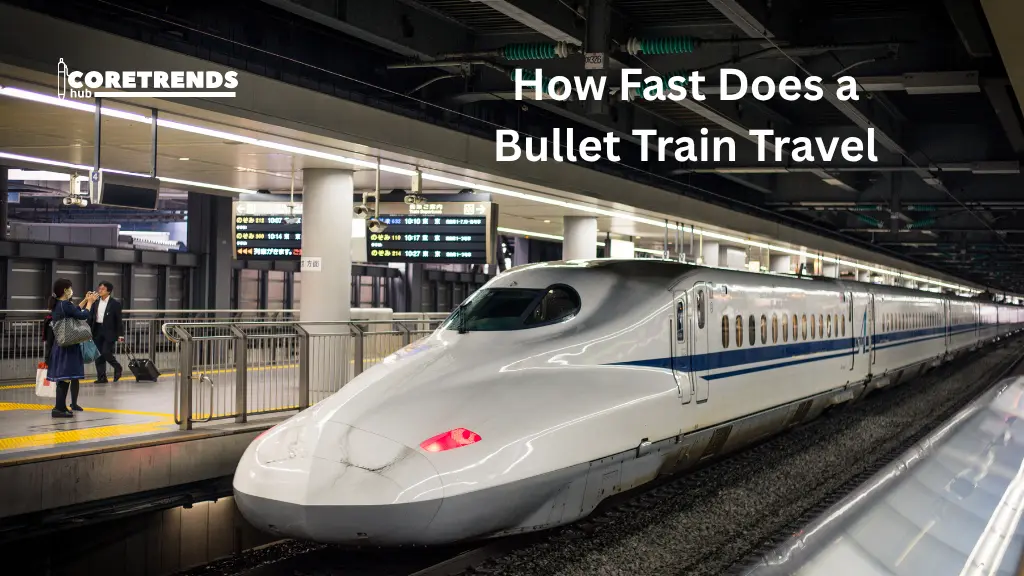A bullet train is a very fast passenger train. It is designed to travel at high speeds on special tracks. These trains are different from regular trains because they can reach speeds of over 300 km/h (186 mph). They are smooth, quiet, and efficient. Bullet trains are often used in countries like Japan, China, and France to connect cities quickly. They are shaped like a bullet, which helps them move faster and reduce air resistance.
High-speed rail is important because it saves time. Traveling by bullet train is much faster than by car or regular train. It also reduces traffic on roads and lowers pollution compared to airplanes or cars. High-speed trains are reliable and can carry many passengers at once. They make commuting between cities easier and support economic growth.
Table of Contents
Types of Bullet Trains
Shinkansen (Japan)
Shinkansen, also known as the “Japanese Bullet Train,” was the world’s first high-speed train. It began operation in 1964 and connects major cities like Tokyo, Osaka, and Kyoto. Shinkansen trains are famous for their punctuality, safety, and smooth ride. They run on dedicated tracks designed specifically for high-speed travel, which allows them to maintain consistent speeds over long distances.
TGV (France)
The TGV (Train à Grande Vitesse) is France’s high-speed rail system. It links major French cities and extends to neighboring countries like Belgium, Switzerland, and Germany. TGV trains can reach speeds of over 320 km/h (200 mph). They are known for comfort, advanced engineering, and energy efficiency, making them a popular choice for both domestic and international travel.
CRH and Fuxing (China)
China’s CRH (China Railway High-speed) and Fuxing trains cover thousands of kilometers across the country. Fuxing trains are the newest models, capable of reaching 350 km/h (217 mph). They use advanced technology for speed, stability, and passenger comfort. These trains connect major cities like Beijing, Shanghai, and Guangzhou, helping reduce travel time significantly.
Other Notable High-Speed Trains
Other countries also have bullet trains, including Spain’s AVE, Germany’s ICE, and Italy’s Frecciarossa. These trains vary in speed, design, and technology but share the same goal: fast, safe, and efficient travel. They help connect cities, reduce road traffic, and provide a modern travel experience.
Top Speeds Achieved by Bullet Trains
Record-Breaking Speeds
Bullet trains are among the fastest trains in the world. Japan’s Shinkansen trains can reach speeds of up to 320 km/h (200 mph) in regular service, while experimental models have achieved over 400 km/h (248 mph). China’s Fuxing trains can run at 350 km/h (217 mph), making them some of the fastest operating trains globally. France’s TGV has set world records, reaching 574.8 km/h (357 mph) in test runs, though its normal service speed is around 320 km/h (200 mph).
Average Operating Speeds
In daily operations, most bullet trains run slightly slower than their top tested speeds. Regular Shinkansen and TGV services maintain speeds between 250–320 km/h (155–200 mph), balancing speed, safety, and energy efficiency. China’s high-speed trains often operate around 300–350 km/h (186–217 mph) on main routes. These speeds allow passengers to travel long distances in hours rather than days, making bullet trains a fast and reliable choice for intercity travel.
Factors Affecting Bullet Train Speed
- Track Design and Quality: The speed of a bullet train depends heavily on the tracks. Smooth, straight tracks allow trains to maintain high speeds safely. Curves, steep slopes, or poor track conditions can reduce speed. Dedicated high-speed rail tracks are built to handle faster trains and minimize vibrations, making travel safer and more efficient.
- Aerodynamics and Train Design: The shape and design of the train affect how fast it can go. Bullet trains are streamlined like a bullet to reduce air resistance. Lightweight materials, smooth surfaces, and pointed noses help trains move faster with less energy. Advanced engineering also keeps trains stable at high speeds.
- Weather and Environmental Conditions: Weather can impact train speed. Heavy rain, snow, or strong winds can force trains to slow down. Temperature changes can affect tracks, so operators adjust speeds to ensure safety. Environmental factors like tunnels and bridges are also considered when planning speed limits.
- Operational and Safety Protocols: Even if trains are capable of high speeds, operators may limit speed for safety reasons. Signaling systems, automatic brakes, and traffic on the tracks can influence how fast a train runs. Safety always comes first, so speed is balanced with risk management.
- Maintenance and Technology Upgrades: Regular maintenance and technological upgrades play a key role in speed. Well-maintained trains and tracks allow for higher speeds without compromising safety. Advanced monitoring systems detect problems early, ensuring that trains can safely operate at top speeds.
Safety Measures at High Speeds
Bullet trains use advanced emergency braking systems to keep passengers safe. These brakes can stop the train quickly in case of obstacles or sudden problems on the track. They are designed to work even at very high speeds without causing harm to passengers.
Automatic Train Control (ATC) systems monitor the train constantly. They check speed, distance, and signals. If the train goes too fast or gets too close to another train, ATC can slow it down or stop it automatically. This reduces accidents caused by human error.
Tracks and infrastructure are also built with safety in mind. High-speed rails are checked regularly for damage or misalignment. Bridges, tunnels, and crossings are specially designed, and most bullet trains run on dedicated tracks to avoid collisions.
Passenger safety is a priority. Trains have secure luggage storage, clear emergency instructions, and trained staff for emergencies. Modern trains also use sensors to monitor speed, temperature, and mechanical performance. Any problem triggers alerts so issues can be fixed immediately.
Technological Innovations Enabling Speed
Bullet trains use lightweight materials to move faster. Modern trains are made with strong but light metals and composites. This reduces weight and allows the train to accelerate quickly while using less energy.
Aerodynamic design is another key innovation. Bullet trains have pointed noses, smooth surfaces, and streamlined shapes. These features reduce air resistance, which lets trains maintain high speeds safely and quietly.
Advanced propulsion systems also help trains go faster. Many bullet trains use powerful electric motors and improved braking systems. These systems provide consistent speed while ensuring stability and control on the tracks.
Signaling and communication technology has improved as well. Modern trains use automatic train control, sensors, and real-time monitoring. This technology ensures safe operation at high speeds and allows trains to travel faster without risking accidents.
Environmental Impact of Bullet Train Travel
Reduced Air Pollution
Bullet trains run on electricity instead of fuel, which helps cut down air pollution. They produce far fewer greenhouse gases than cars or airplanes. Many countries are now using renewable energy sources, like wind or solar power, to run these trains, making them even cleaner and better for the environment.
Lower Traffic and Carbon Emissions
High-speed trains can carry hundreds of passengers in one trip. This means fewer cars on the road and fewer flights between cities. As a result, overall carbon emissions drop. This helps reduce traffic congestion and supports efforts to fight climate change.
Energy Efficiency and Design
Bullet trains are built to be light and aerodynamic. Their smooth design helps them move faster while using less energy. Compared to cars and planes, they use much less energy per passenger, making them one of the most efficient ways to travel long distances.
Environmental Challenges
While bullet trains are eco-friendly, building their networks can affect the environment. Construction may disturb land, wildlife, and local habitats. However, once completed, bullet trains help balance this impact by offering a greener, long-term transportation solution that promotes cleaner air and sustainable travel.
Conclusion
Bullet trains are one of the fastest and most efficient ways to travel. They can reach speeds of over 300 km/h, allowing people to move quickly between cities. Their design, technology, and safety systems make travel smooth, safe, and reliable.
High-speed trains also help the environment by reducing traffic and pollution. They save time, energy, and support cleaner transportation. As technology improves, bullet trains will likely become even faster and more advanced. In short, they represent the future of modern travel fast, safe, and eco-friendly.



